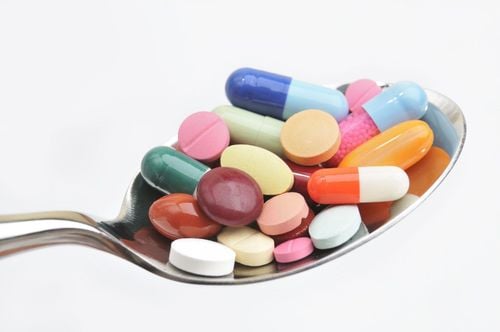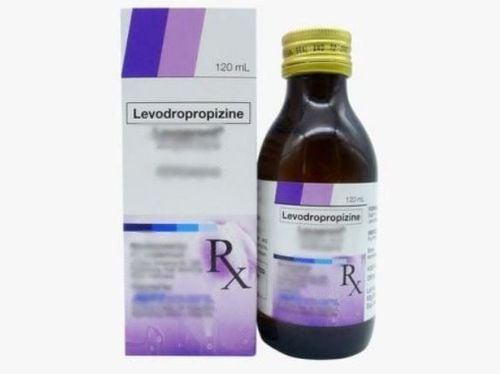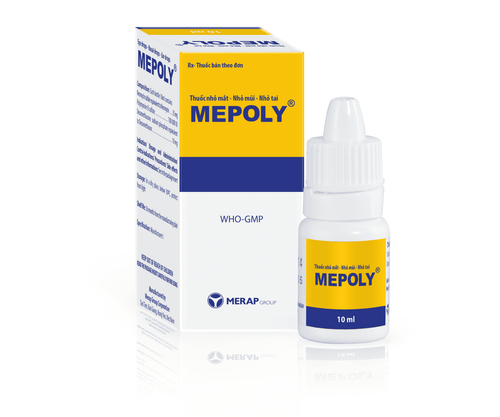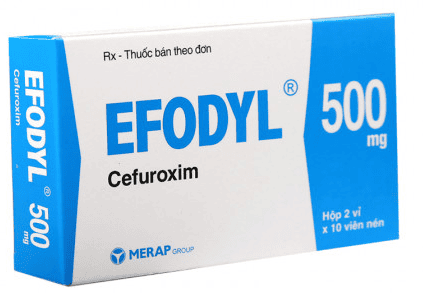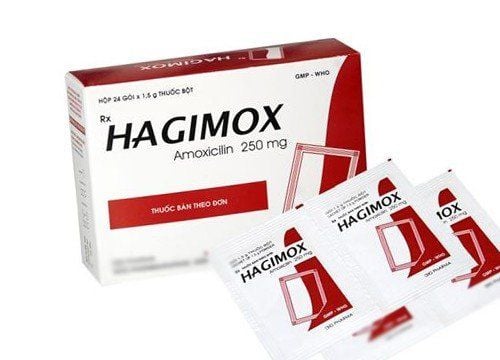This is an automatically translated article.
Pulracef drug with the main ingredient is Cefuroxime, used in the treatment of diseases such as: otitis media, sinusitis, pneumonia, acute bronchitis, pyelonephritis, boils, typhoid fever, gonorrhea, ....
1. What is Pulracef?
Pulracef belongs to the group of antiparasitic, anti-infective, anti-viral, anti-fungal drugs. Pulracef is prepared in the form of film-coated tablets and packed in boxes of 10 blisters x 10 tablets. Pulracef medicine has the main ingredient Cefuroxime 500mg and other excipients just enough for 1 tablet.2. Pulracef drug effect
Pulracef is used in the following cases:
Otitis media, tonsillitis, laryngitis, sinusitis, pharyngitis. Pneumonia, exacerbation of chronic bronchitis, acute bronchitis. Acute and chronic pyelonephritis, cystitis & urethritis. Pimples, pustular dermatitis, impetigo. Typhoid fever. Gonorrhea, cervicitis. Acute gonorrhea urethritis.
3. Dosage and how to use Pulracef
Pulracef is used orally in the form of tablets or suspension, take Pulracef 5-10 days and take it after meals
Dosage of Pulracef refer to the following:
Adults:
Treatment of infections: Dosage Normally 250mg Cefuroxime x 2 times / day. Treatment of typhoid fever is 500mg Cefuroxime x 2 times/day. Treatment of urogenital infections with a dose of 125mg Cefuroxime x 2 times/day. Treatment of mild to moderate lower respiratory tract infections: 250mg Cefuroxime / time x 2 times / day; Severe cases and suspected pneumonia: dose of 500mg Cefuroxime/time x 2 times/day; Treatment of pyelonephritis 250mg Cefuroxime / time x 2 times / day. Uncomplicated gonorrhea single dose of 1g Cefuroxime. Early stage Lyme disease: 500mg Cefuroxime dose twice a day, for 20 days. Children:
Treatment of infections: Use the usual dose of 125mg Cefuroxime/time x 2 times/day, maximum dose of 250mg Cefuroxime/time. Typhoid fever dose 250mg Cefuroxime / time x 2 times / day. Children 2 years of age and older with otitis media or serious infections receive 250mg Cefuroxime / time x 2 times / day.
4. Contraindications to the use of Pulracef
Pulracef should not be used in patients with hypersensitivity to cephalosporins.
5. What side effects does Pulracef cause?
During the use of Pulracef, patients may encounter some unwanted side effects as follows:
Erythema multiforme, toxic skin necrosis, Steven-Johnson syndrome, toxic epidermal necrolysis , skin rash, urticaria, pruritus, Drug fever Serum sickness. Diarrhea, nausea, vomiting Eosinophils, liver enzymes increased, Serum creatinine increased slightly, AST, ALT increased, cholestatic jaundice. Rarely, pseudomembranous enterocolitis. Anaphylactic reaction Candida infection. Nephrotoxicity with transient elevation of blood urea and serum creatinine. Interstitial nephritis. Convulsions (if the dose is high and the patient has renal failure), headache, agitation. Athritis. Patients should inform their doctor about the undesirable effects encountered when taking Pulracef.
6. Precautions when using Pulracef
Pulracef is prescribed by a doctor, patients need to strictly follow the instructions of the doctor or pharmacist. Pulracef should be used with caution in patients who are allergic to penicillins, cephalosporins or other drugs. Patients with diarrhea should note the diagnosis of pseudomembranous enterocolitis after taking antibiotics. Pulracef should be used with caution in pregnant and lactating women. Pulracef should be used during pregnancy only if clearly needed. Cefuroxime components are excreted in breast milk but at low concentrations and do not affect the nursing infant. However, if your child has diarrhea, thrush and a rash, stop taking the medicine and notify the doctor. There have been reports of cross-hypersensitivity - anaphylaxis occurring in patients allergic to beta-lactam antibiotics, so Pulracef should be used with caution and ready to go for the treatment of anaphylaxis. Use cefuroxime to protect patients who are allergic to penicillin. Pulracef should be used with caution when co-administered with potent diuretics, because of possible adverse effects on renal function. Prolonged use of Cefuroxime may cause overgrowth of non-susceptible strains of bacteria. Patients should be closely monitored; if serious superinfection occurs during treatment, Pulracef should be discontinued.
7. What should I do when I overdose on Pulracef?
In case of overdose of Pulracef, it mostly causes nausea/vomiting, diarrhea. However, a few cases can cause neuromuscular hyperexcitability reactions and convulsions, especially in patients with renal failure.
Treatment: Patients should be concerned about the possibility of an overdose of Pulracef, protect the respiratory tract and support ventilation and infusion for the patient. If the patient develops seizures, discontinue Pulracef immediately. Anticonvulsant therapy may be used if clinically indicated. Hemodialysis can remove Pulracef from the blood, but most often treatment is supportive or symptomatic.
8. Pulracef drug interactions
Cefuroxime combined with Ranitidine with sodium bicarbonate may reduce the bioavailability of Cefuroxime. Cefuroxime should be administered at least 2 hours after antacids or H2 blockers, as these may increase gastric pH. Concomitant use of cefuroxime with probenecid at high doses may result in decreased renal clearance of cefuroxime, higher and more prolonged plasma concentrations of cefuroxime. Aminoglycosides increase the potential for nephrotoxicity when co-administered with Cefuroxime. Pulracef drug has the main ingredient Cefuroxime, used in the treatment of diseases such as: otitis media, sinusitis, pneumonia, acute bronchitis, pyelonephritis, boils, typhoid fever, gonorrhea, . ... In order to ensure effective treatment and avoid unwanted side effects, patients need to strictly follow the instructions of doctors, professional pharmacists.
Follow Vinmec International General Hospital website to get more health, nutrition and beauty information to protect the health of yourself and your loved ones in your family.





